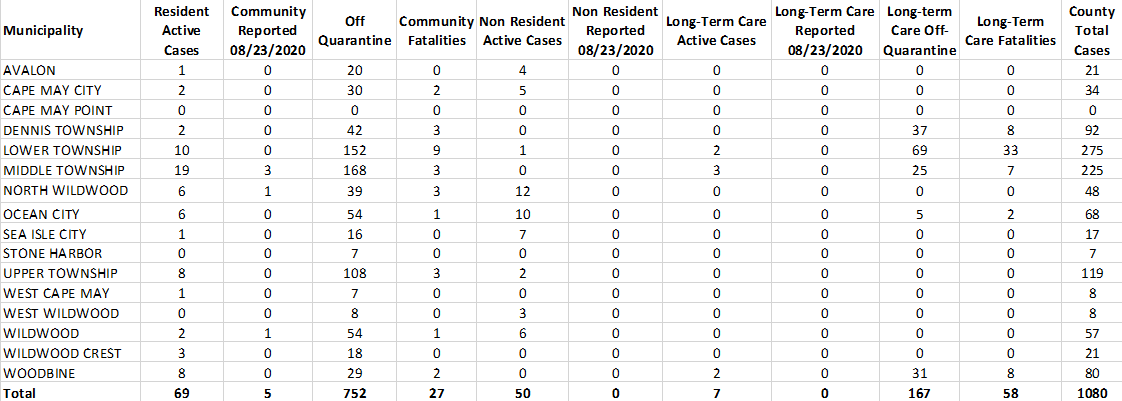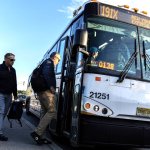COURT HOUSE – Aug. 23: The County of Cape May Department of Health is reporting five new positive cases among county residents and no new out-of-county positive cased that is included in the non-resident active cases listed below. The county is thankful to have zero new deaths to report today.
According to a release, New Jersey has 189,494 total COVID-19 positive cases and 14,117 deaths. Total positive cases of COVID-19 infection in Cape May County is now 1,080, including 85 deaths.
NJDOH Social Distancing Guidance for Schools
1. Are districts responsible for maintaining social distancing in all buses, classrooms, bathrooms and school spaces at all times?
Face coverings should be worn by all staff, students, and visitors in accordance with the updated guidance.
In addition to wearing face coverings, schools and districts must implement policies that allow for social distancing within the classroom to the maximum extent practicable. This can be achieved by ensuring students are seated at least six feet apart. If schools are not able to maintain this physical distance, additional modifications should be considered. These include using physical barriers between desks and turning desks to face the same direction (rather than facing each other) or having students sit on only one side of the table, spaced apart.
Policies must be designed so that all instructional and non-instructional rooms (e.g. bathrooms, common areas, and auditoriums) in school and district facilities comply with social distancing standards to the maximum extent practicable. Any modifications to school district facilities should be in coordination with local code officials and Department county offices to ensure that alterations adhere to school safety requirements.
School districts should enact policies to maintain social distancing practices on buses (at least six feet of distance between riders) to the maximum extent practicable. Several methods are available to achieve such social distancing:
a. The CDC recommends that school districts modify the manner students are seated on a school bus such that there is one student seated per row, skipping a row between each child, if possible. Under this scenario, a 54-passenger bus would only have 11 passengers (seating students who reside in the same household in the same row, whenever possible, would increase capacity).
b. Alternatively, a district may consider seating one student per row, doubling the vehicle’s capacity.
i. For example, several companies have started marketing physical barriers that separate rows on a school bus. Such equipment would allow students to be seated in each row, thereby doubling the socially distant capacity that was previously noted. Entities that oversee the safety of school buses, the New Jersey Motor Vehicle Commission and federal regulators, would need to approve the use of such equipment.
2. What is the current research on the relationship between the length of time an individual spends in close proximity to another and the level of risk of contracting COVID-19? For example, what is the increased degree of risk for students in a school building for 6 hours vs 4 hours vs the hour an individual may be in a hair salon?
There are many factors that determine the likelihood of an individual becoming infected. Such factors include the infectivity of infected individuals, whether face coverings are
worn, and conditions in the physical environment (indoor vs outdoor, air circulation, etc.). As such, it is impossible to directly quantify risk over time. However, it is clear that prolonged exposure without proper social distancing or face coverings increases risk.
3. What does research tell us about the specific ventilation standards that should be in place to provide safe learning environments? How often should these systems be inspected for compliance with these standards?
Per the Public Employees Occupational Safety and Health (PEOSH) standards, all schools are covered by the Indoor Air Quality standard (N.J.A.C. 12:100-13).
The standard provides requirements for HVAC inspection, maintenance and maintaining acceptable IAQ indicators, i.e., temperature, carbon dioxide levels, etc. There is extensive information on the PEOSH website, including guidance, checklists and a model of a written Indoor Air Quality program.
4. Will there be an expectation that a second adult will be on each school bus in order to enforce social distancing and wearing masks so that the driver can focus on the road and the students will comply?
There is no NJDOE COVID-19 anticipated minimum standard that school buses require additional staff. Staffing decisions remain in the purview of the board of education. The NJDOE encourages school district Restart Committees to consider methods for implementing the minimum anticipated standards described in the Road Back in a manner that reflects local needs and circumstances.
5. What notifications are required to the school community when there is an exposure? Timing? Method of communication? What notifications are required to the school community when there is a positive test result of a teacher/student / staff member?
As outlined in The Road Back, if the school district becomes aware that an individual who has spent time in a district facility tests positive for COVID-19, district officials must immediately notify local health officials, staff, and families of a confirmed case while maintaining confidentiality. Notification procedures must be consistent with the district’s contact tracing policy to the maximum extent practicable.
Districts should work with their local health department and follow CDC guidelines for illness reporting. They should also work with their local health department to develop written protocols to address a positive case.
6. Are school facilities open to the communities for recreational use?
Yes, in accordance with the NJDOE’s “The Road Back: Restart and Recovery Plan for Education.” As noted in Critical Area of Operation #10, all extracurricular activities that are otherwise permitted must comply with applicable social distancing requirements and hygiene protocol. External community organizations that use school facilities must follow district guidance on health and safety protocols.
7. How should districts accommodate class activities with shared objects, such as art supplies or musical instruments?
As stated on page 10 of “The Road Back: Restart and Recovery for Education,” school districts should avoid or limit sharing objects and equipment. When sharing is unavoidable, objects and equipment should be disinfected between uses.
8. If there is an apparent conflict between recommendations set forth in the American Academy of Pediatrics (AAP) standards and CDC guidelines, which set of standards should districts abide by?
Districts should comply with those provisions identified as anticipated minimum standards in the Department’s reopening guidance, which was developed in consultation with the NJ Department of Health. All other resources referenced throughout the guidance, such as the AAP standards and CDC guidelines, are designed to support local decision-making and consultation with local health officials.
9. If a parent opts-out of sending their child to school, can they still participate in sports or other extra-curricular activities?
Yes. Students may still participate in sports and extra-curricular activities if they are utilizing the full-time remote learning option if such sports and extra-curricular activities are otherwise permitted.








